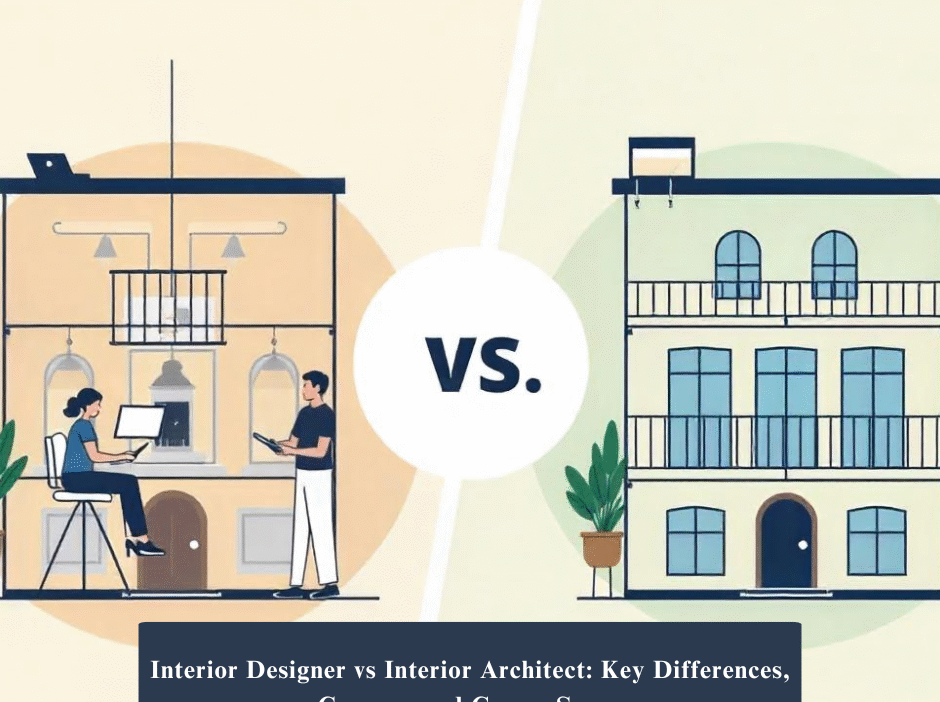Let’s be honest—choosing what to study after 12th can feel overwhelming, especially if you’re a creative thinker torn between multiple options. If you love designing spaces, paying attention to colors, layouts, or how people feel in a room, you’ve probably googled:
“Interior designer vs interior architect—what’s the difference?”
You’re not alone.
Before diving into courses, colleges, or career paths, let’s break down what these roles actually involve, how they’re different, and how they can open doors to exciting industries like business, tech, wellness, education, and more.
First Things First: Who Does What?
🪄 Interior Designer
Think of an interior designer as someone who transforms a space from ordinary to inspiring. They play with furniture, textures, lighting, and layout to make a room functional and beautiful. They don’t knock down walls—they style around them.
They’re creative problem-solvers who:
- Work closely with clients
- Choose colors, materials, and decor
- Make homes, cafes, and workspaces feel just right
🏗 Interior Architect
Interior architects dive deeper. They might actually change the structure of the space. That could mean removing walls, altering floor plans, or redesigning the entire interior layout of a building with technical expertise.
They’re part-architect, part-designer, and they:
- Focus on space planning and flow
- Understand building codes and safety
- Collaborate with engineers and architects
In short: Interior designers decorate and optimize space; interior architects restructure and reimagine it.
What Should You Study After 12th?
If you’re creative and ready to explore the world of space design, there are some great designing courses after 12th that lead into both these paths.
🎓 Popular Options:
- B Interior Design: A creative, hands-on course that teaches you to design interiors, understand client needs, and express your ideas visually. Ideal if you love mood boards, color theory, and storytelling through space.
- B.Design in Interior or Spatial Design: A more holistic course that introduces you to broader design thinking with a focus on interiors.
- Architecture (B.Arch): More technical, longer in duration (5 years), and includes structural knowledge. Best if you’re leaning toward interior architecture.
Make sure the course you pick offers studio-based learning, real-world exposure, and creative freedom. You’ll want to experiment, build models, and work on live projects.
Where Can This Career Take You? (Hint: It’s Not Just Houses)
Let’s bust the myth: interior design isn’t just about designing living rooms or fancy lobbies. In fact, space design is at the heart of how every modern business works today.
💼 In Business and Branding
Big brands use interior design to tell their story. Think Apple stores, Starbucks, or co-working spaces like WeWork—each has a strong vibe, and that vibe is designed.
🧘♀️ In Wellness & Hospitality
From spas and yoga studios to hospitals and mental health centers—spaces are now created with mood, healing, and energy in mind. Designers help build calm, inclusive environments.
🧑🏫 In Education
Schools, universities, and learning labs are being reimagined. Collaborative corners, color-coded areas, and open layouts are all part of a thoughtful design process.
🌍 In Sustainability & Smart Living
Green materials, solar lighting, smart homes—yes, designers play a key role here too. If you care about the planet, this career lets you make a difference.
Hot Trends in 2025 You Should Know
If you’re stepping into this industry, here’s what’s trending (and will stay hot for a while):
- Biophilic Design: Bringing nature into interior spaces—plants, earthy materials, natural light.
- Modular & Flexible Spaces: Think foldable walls, mobile furniture, work-from-anywhere setups.
- Design for Mental Health: Calming colors, sensory experiences, and clutter-free environments.
- Tech-Driven Design: Using AR/VR to present ideas, 3D renders for walkthroughs, and smart systems for lighting and climate control.
- Cultural Design: Blending tradition and innovation to create unique, identity-driven spaces.
Whether you become an interior designer or an interior architect, staying updated on these trends will keep your work fresh, relevant, and future-ready.
Final Thoughts: Which Path Should You Take?
There’s no “better” choice in the debate of interior designer vs interior architect—only the one that aligns with you.
Choose a path toward interior architecture if:
- You’re more technical and curious about how structures work
- You want to redesign spaces at the layout level
- You enjoy solving spatial challenges from the ground up
Choose B Interior Design if:
- You love decorating and storytelling through space
- You enjoy working closely with people
- You care about style, comfort, and visual harmony
Whatever you pick, this career isn’t just about designing walls—it’s about shaping how people live, feel, and connect.



